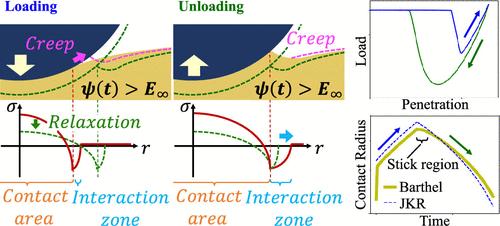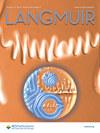Atomic Force Microscopy Analysis of Velocity Dependent Adhesive Viscoelastic Contact
IF 3.7
2区 化学
Q2 CHEMISTRY, MULTIDISCIPLINARY
引用次数: 0
Abstract
Adhesive contact phenomena play a crucial role in various scientific and engineering fields. However, considering viscoelasticity, which is essential for understanding practical applications involving soft materials like polymers, makes analysis challenging. Traditional elastic contact models such as the Johnson–Kendall–Roberts and Maugis–Dugdale models often fail to account for viscoelastic behavior. In this study, rate-dependent viscoelastic adhesive contacts were analyzed using atomic force microscopy force–distance curve measurements, comparing the elastic models with the viscoelastic model proposed by Barthel. The force curve analysis, conducted with the Barthel model for the first time, reveals that viscoelastic behaviors inside the contact area and the interaction zone both affect the contact state. These viscoelastic behaviors result in phenomena specific to viscoelastic contact, such as the “stick region” and the apparent work of adhesion. The Barthel model successfully captures the rate dependence of the contact situation, promoting a comprehensive understanding of viscoelastic adhesive contact phenomena.

原子力显微镜分析速度依赖性粘合剂粘弹性接触
粘合接触现象在各种科学和工程领域都发挥着至关重要的作用。然而,粘弹性对于理解涉及聚合物等软材料的实际应用至关重要,因此考虑粘弹性会使分析具有挑战性。传统的弹性接触模型,如 Johnson-Kendall-Roberts 模型和 Maugis-Dugdale 模型,往往无法考虑粘弹性行为。在本研究中,我们使用原子力显微镜力-距离曲线测量法分析了随速率变化的粘弹性粘合接触,并将弹性模型与 Barthel 提出的粘弹性模型进行了比较。首次使用 Barthel 模型进行的力曲线分析表明,接触区和相互作用区内的粘弹性行为都会影响接触状态。这些粘弹性行为导致了粘弹性接触特有的现象,如 "粘滞区 "和表面粘附功。Barthel 模型成功捕捉了接触状态的速率依赖性,促进了对粘弹性粘合接触现象的全面理解。
本文章由计算机程序翻译,如有差异,请以英文原文为准。
求助全文
约1分钟内获得全文
求助全文
来源期刊

Langmuir
化学-材料科学:综合
CiteScore
6.50
自引率
10.30%
发文量
1464
审稿时长
2.1 months
期刊介绍:
Langmuir is an interdisciplinary journal publishing articles in the following subject categories:
Colloids: surfactants and self-assembly, dispersions, emulsions, foams
Interfaces: adsorption, reactions, films, forces
Biological Interfaces: biocolloids, biomolecular and biomimetic materials
Materials: nano- and mesostructured materials, polymers, gels, liquid crystals
Electrochemistry: interfacial charge transfer, charge transport, electrocatalysis, electrokinetic phenomena, bioelectrochemistry
Devices and Applications: sensors, fluidics, patterning, catalysis, photonic crystals
However, when high-impact, original work is submitted that does not fit within the above categories, decisions to accept or decline such papers will be based on one criteria: What Would Irving Do?
Langmuir ranks #2 in citations out of 136 journals in the category of Physical Chemistry with 113,157 total citations. The journal received an Impact Factor of 4.384*.
This journal is also indexed in the categories of Materials Science (ranked #1) and Multidisciplinary Chemistry (ranked #5).
 求助内容:
求助内容: 应助结果提醒方式:
应助结果提醒方式:


